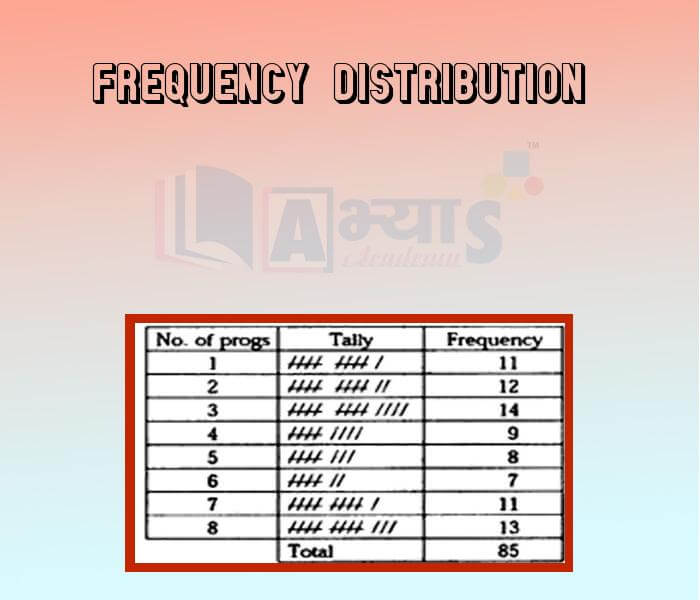Frequency Distribution





Frequency Distribution
Frequency Distribution:
Frequency table or frequency distribution is a method to present raw data in the form, from which on can easily understand the information contained in the raw data. Frequency distributions are of two types:
Discrete Frequency Distribution :
The process of preparing this type of distribution is very simple. The construction of a discrete frequency distribution from the given raw data is done by the use of the method of tally marks. In the first column of the frequency table we write all possible values of the variable from the lowest to the highest.
Illustration : Draw a discrete frequency distribution of the number of children in 20 families: 1,1,2,3,4,3,2,1,1,4,5,2,4,2,2,1,3,3,2,5
Solution : The data may be put in the form of a discrete frequency distribution as follows:
|
No. of children |
Tally bars |
Frequency |
| 1 |  |
5 |
| 2 |  |
6 |
| 3 | IIII | 4 |
| 4 | III | 3 |
| 5 | II | 2 |
A random survey of numbers of children of various age group playing in a park was found as follows. Children playing under the age of 17 years are:
| |||||||||||||||||||
| Right Option : C | |||||||||||||||||||
| View Explanation | |||||||||||||||||||
30 children were asked about the number of hours, they watched TV programs in previous week. The results are as follows: 1, 6, 2, 3, 5, 12, 5, 8, 4, 8 10, 3, 4, 12, 2, 8, 15, 1, 17, 6, 3, 2, 8, 5, 9, 6, 8, 7, 14, 12 . How many children watch TV between 10-15 hours? | |||
| Right Option : C | |||
| View Explanation | |||
Find the frequency of Class 100-120 by using the given data:
| |||||||||||||||||
| Right Option : C | |||||||||||||||||
| View Explanation | |||||||||||||||||
Students / Parents Reviews [10]
About Abhyas metholodology the teachers are very nice and hardworking toward students.The Centre Head Mrs Anu Sethi is also a brilliant teacher.Abhyas has taught me how to overcome problems and has always taken my doubts and suppoeted me.

Shreya Shrivastava
8thMy experience with Abhyas is very good. I have learnt many things here like vedic maths and reasoning also. Teachers here first take our doubts and then there are assignments to verify our weak points.

Shivam Rana
7thI have spent a wonderful time in Abhyas academy. It has made my reasoning more apt, English more stronger and Maths an interesting subject for me. It has given me a habbit of self studying

Yatharthi Sharma
10thIt was good as the experience because as we had come here we had been improved in a such envirnment created here.Extra is taught which is beneficial for future.

Eshan Arora
8thIt has a great methodology. Students here can get analysis to their test quickly.We can learn easily through PPTs and the testing methods are good. We know that where we have to practice

Barkha Arora
10thMy experience was very good with Abhyas academy. I am studying here from 6th class and I am satisfied by its results in my life. I improved a lot here ahead of school syllabus.

Ayan Ghosh
8thOne of the best institutes to develope a child interest in studies.Provides SST and English knowledge also unlike other institutes. Teachers are co operative and friendly online tests andPPT develope practical knowledge also.

Aman Kumar Shrivastava
10thAbhyas Methodology is very good. It is based on according to student and each child manages accordingly to its properly. Methodology has improved the abilities of students to shine them in future.

Manish Kumar
10thMy experience with Abhyas academy is very good. I did not think that my every subject coming here will be so strong. The main thing is that the online tests had made me learn here more things.

Hiya Gupta
8thIt was a good experience with Abhyas Academy. I even faced problems in starting but slowly and steadily overcomed. Especially reasoning classes helped me a lot.
